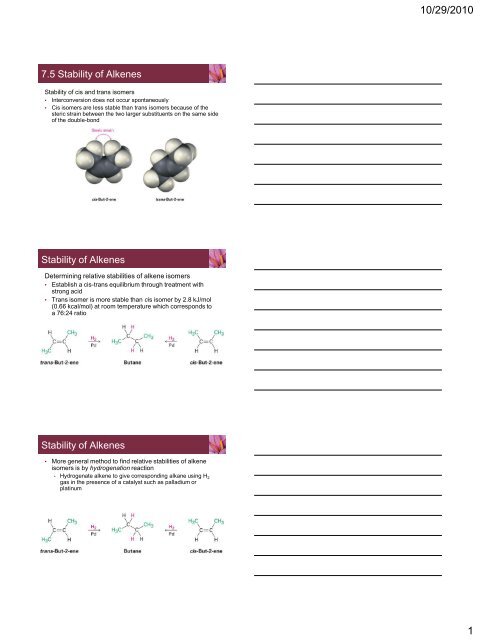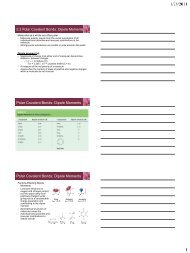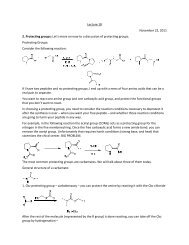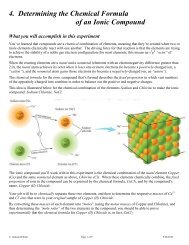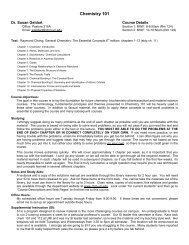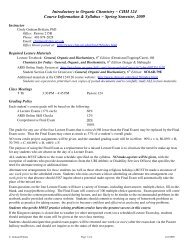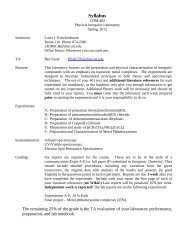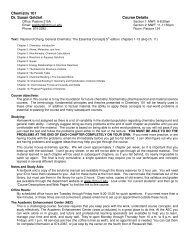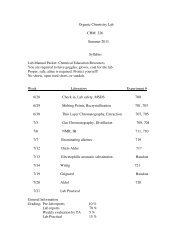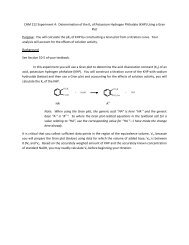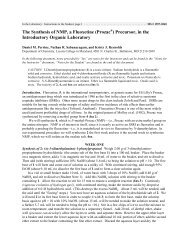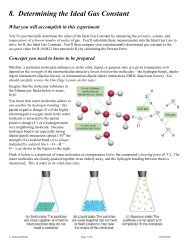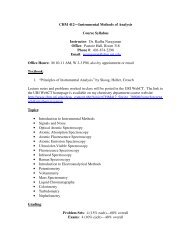Alkenes and Alkynes - URI Department of Chemistry
Alkenes and Alkynes - URI Department of Chemistry
Alkenes and Alkynes - URI Department of Chemistry
- No tags were found...
You also want an ePaper? Increase the reach of your titles
YUMPU automatically turns print PDFs into web optimized ePapers that Google loves.
10/29/20107.5 Stability <strong>of</strong> <strong>Alkenes</strong>Stability <strong>of</strong> cis <strong>and</strong> trans isomers• Interconversion does not occur spontaneously• Cis isomers are less stable than trans isomers because <strong>of</strong> thesteric strain between the two larger substituents on the same side<strong>of</strong> the double-bondStability <strong>of</strong> <strong>Alkenes</strong>Determining relative stabilities <strong>of</strong> alkene isomers• Establish a cis-trans equilibrium through treatment withstrong acid• Trans isomer is more stable than cis isomer by 2.8 kJ/mol(0.66 kcal/mol) at room temperature which corresponds toa 76:24 ratioStability <strong>of</strong> <strong>Alkenes</strong>• More general method to find relative stabilities <strong>of</strong> alkeneisomers is by hydrogenation reaction• Hydrogenate alkene to give corresponding alkane using H 2gas in the presence <strong>of</strong> a catalyst such as palladium orplatinum1
10/29/2010Stability <strong>of</strong> <strong>Alkenes</strong>Energy Diagram for Hydrogenation <strong>of</strong> cis- <strong>and</strong> trans- But-2-ene• Cis isomer is higher energy than the trans isomer• More energy released in the hydrogenation <strong>of</strong> the cis isomer than thetrans isomerStability <strong>of</strong> <strong>Alkenes</strong>• Energy Diagram for Hydrogenation <strong>of</strong> cis- <strong>and</strong> trans- But-2-ene• Cis isomer is higher energy than the trans isomer• More energy released in the hydrogenation <strong>of</strong> the cis isomer thanthe trans isomerStability <strong>of</strong> <strong>Alkenes</strong>Compare heats <strong>of</strong> hydrogenation ( H° hydrog ) for cis <strong>and</strong>trans isomers• Trans isomer is more stable than cis isomer by 4kJ/mol2
10/29/2010Stability <strong>of</strong> <strong>Alkenes</strong><strong>Alkenes</strong> become more stable with increasing substitutionStability <strong>of</strong> <strong>Alkenes</strong>Stability <strong>of</strong> <strong>Alkenes</strong>Stability order due to two factors• Hyperconjugation• Stabilizing interaction between the C=C bond <strong>and</strong> adjacent C-Hσ bonds on substituents• The more substituents there are the greater the stabilization <strong>of</strong> thealkene3
10/29/2010Electrophilic Addition Reactions <strong>of</strong> <strong>Alkenes</strong>Mechanism <strong>of</strong> the acid-catalyzed electrophilic addition <strong>of</strong> H 2 O to2-methylpropene to give the alcohol 2-methylpropan-2-olElectrophilic Addition Reactions <strong>of</strong> <strong>Alkenes</strong>Mechanism <strong>of</strong> the acid-catalyzed electrophilic addition <strong>of</strong> H 2 O to2-methylpropene to give the alcohol 2-methylpropan-2-olElectrophilic Addition Reactions <strong>of</strong> <strong>Alkenes</strong>This is a good time to mention that organic reaction equations aresometimes written in different ways to emphasize different points.In describing a laboratory process, for example, the reaction <strong>of</strong> 2-methylpropene with HCl might be written in the format A + B → Cto emphasize that both reactants are equally important for thepurposes <strong>of</strong> the discussion. The solvent <strong>and</strong> notes about otherreaction conditions, such as temperature, are written either aboveor below the reaction arrow:5
10/29/2010Electrophilic Addition Reactions <strong>of</strong> <strong>Alkenes</strong>Alternatively, we might write the same reaction in a format toemphasize that 2-methylpropene is the reactant whosechemistry is <strong>of</strong> greater interest. The second reactant, HCl, isplaced above the reaction arrow together with notes aboutsolvent <strong>and</strong> reaction conditions:Electrophilic Addition Reactions <strong>of</strong> <strong>Alkenes</strong><strong>Alkynes</strong> also undergo electrophilic addition reactions• Reactivity is substantially less than that <strong>of</strong> alkenes7.7 Orientation <strong>of</strong> Electrophilic Addition:Markovnikov’s RuleRegiospecific reactions - reactions where only one <strong>of</strong>two possible orientations occursMarkovnikov’s Rule (Vladimir Markovnivov,1869)• In the addition <strong>of</strong> HX to an alkene, the H attaches to thecarbon with fewer alkyl substituents <strong>and</strong> the X attaches tothe carbon with more alkyl substituents6
10/29/2010Orientation <strong>of</strong> Electrophilic Addition:Markovnikov’s RuleOrientation <strong>of</strong> Electrophilic Addition:Markovnikov’s Rule• When both double-bond carbon atoms have the samedegree <strong>of</strong> substitution, a mixture <strong>of</strong> addition products resultsOrientation <strong>of</strong> Electrophilic Addition:Markovnikov’s Rule (Restated)Markovnikov’s rule (restated)• In the addition <strong>of</strong> HX to an alkene, the more highly substitutedcarbocation is formed as the intermediate rather than the less highlysubstituted one7
10/29/2010Orientation <strong>of</strong> Electrophilic Addition:Markovnikov’s Rule (Restated)Worked Example 7.2Predicting the Product <strong>of</strong> an Electrophilic AdditionReactionWhat product would you expect from reaction <strong>of</strong> HClwith 1-ethylcyclopentene?Worked Example 7.3Synthesizing a Specific CompoundWhat alkene would you start with to prepare thefollowing alkyl halide?(There may be more than one possibility.)8
10/29/20107.8 Carbocation Structure <strong>and</strong> StabilityWhy Markovnikov’s Rule worksStructure <strong>of</strong> carbocations• Carbocations are planar• The trivalent carbon is sp 2hybridized <strong>and</strong> has a vacant porbital perpendicular to theplane <strong>of</strong> the carbon• Carbon has three attachedgroupsCarbocation Structure <strong>and</strong> StabilityStability• Thermodynamic measurements show that the stability <strong>of</strong>carbocations increases with increasing substitution.Carbocation Structure <strong>and</strong> Stability• More highly substituted carbocations are more stablethan less highly substituted ones• Inductive effect• The more alkyl groups that are attached to the positivelycharged carbon, the more electron density shifts toward thecharge <strong>and</strong> the more inductive stabilization <strong>of</strong> the cationoccurs9
10/29/2010Carbocation Structure <strong>and</strong> Stability• Hyperconjugation• the stabilizing interaction between a p orbital <strong>and</strong> properlyoriented C-H σ bonds on neighboring carbons• The more alkyl groups that are on the carbocation the morestable the carbocation10


